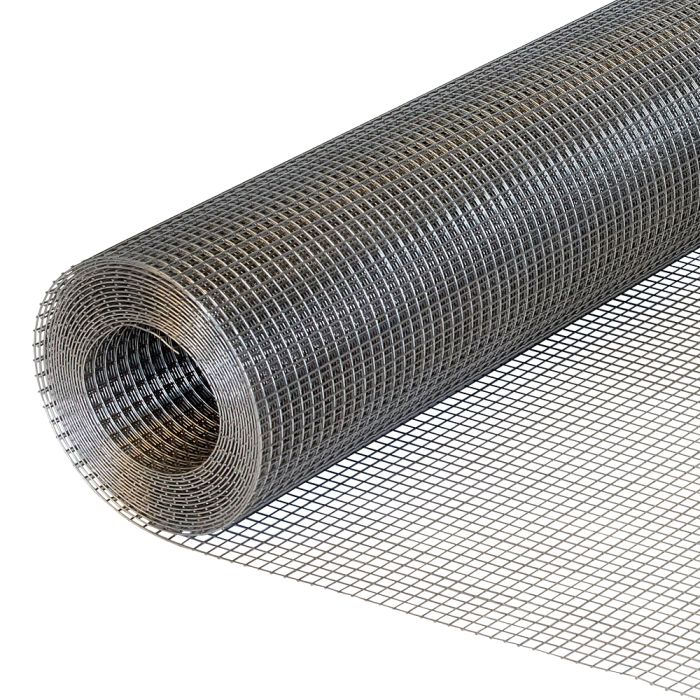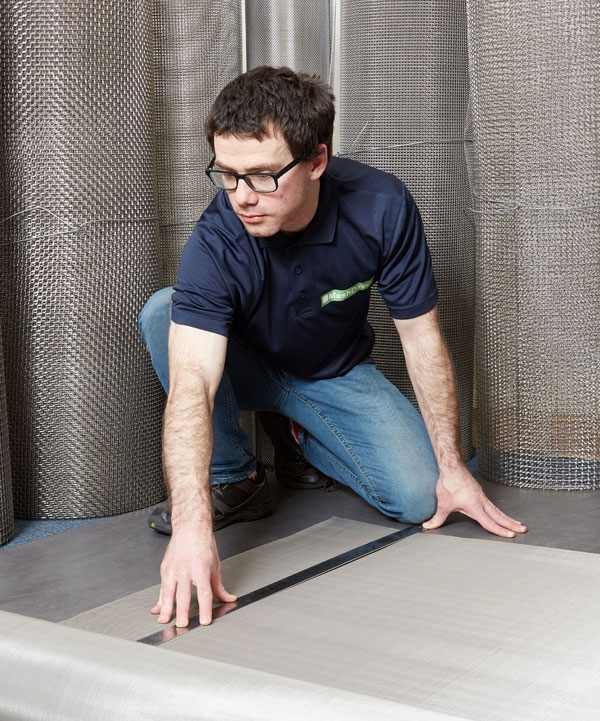Stainless Steel Wire Mesh 13 x 13 mm holes 16 gauge
Stainless Steel Wire Mesh 13 x 13 mm holes 16 gauge
| Size | Price | Qty | |
|---|---|---|---|
Grade 304 Stainless Steel, Width 1.2m (4ft) |
|||
|
1.2m high (4ft), sold per metre, Grade 304
Code: SSWELD1(W4) More info Less info Grade 304 stainless steel welded mesh. The wire gauge (or "g") refers to the thickness of the wire. Although it is counter-intuitive, the lower the wire gauge number the thicker the wire is. For example, a 16g wire is thicker than a 19g wire. |
|
||
|
1.2m high x 10m roll, Grade 304
Imperial Measurements: (48 inch x 32ft) Code: SS8 More info Less info Grade 304 stainless steel welded mesh. The wire gauge (or "g") refers to the thickness of the wire. Although it is counter-intuitive, the lower the wire gauge number the thicker the wire is. For example, a 16g wire is thicker than a 19g wire. |
|
||
Description
Stainless steel is highly resistant to corrosion, and therefore is longer lasting than a galvanized finish mesh. Stainless steel is commonly used in the food industry, but has a wide variety of applications where a higher level of rust resistance is required.
This product is a medium to heavy-weight welded wire mesh, which is an excellent choice for strong, long lasting bird protection against large and small birds. As well as birds, this mesh will also keep out rats and squirrels.
The 16 gauge wire (approx. 1.6mm thick), combined with the small 13mm hole size, provides the mesh with strength and rigidity.
Specification
- Material: Grade 304 stainless steel.
- Hole size: 13mm (1/2 inch).
- Wire thickness: 16 gauge (1.6mm).
- Weight per square metre: Approx. 2500 grams.
- Roll Heights: The heights of the rolls are manufactured to imperial measurements (feet and inches). We have rounded down the metric height conversions for simplicity. The accurate metric height is as follows: 1220mm (4ft) high.
All measurements +/- 15%. If you require a micrometer reading of the wire thickness then please call us on 01782 820 970.
Reviews
Reviews
Delivery & Returns
Delivery and returns
You can rest assured that we will always do our utmost to deliver your goods as quickly as possible. Your order will be delivered with an accredited courier or pallet carrier, and we also carry large stocks in our warehouse which allows us to dispatch goods quickly.
Although we understand that speed of delivery is very important to our customers, a delay in the courier networks is always a possibility, and on occasions orders can also be delivered as a split delivery. For this reason, it's not possible for an online business to 100% guarantee delivery dates. However, should a delay with the couriers occur we will do our very best to resolve this as a matter of urgency.Delivery Costs:
Mainland England & Wales Postcodes
Orders over £60:
Standard service up to 3 Working Days (any order over £60.00) - FREE
Express Delivery service 1 to 2 Working Days (any order over £60.00) - £6.98 per order
Orders under £60:
Standard service up to 3 Working Days (any order under £60.00) - £6.98 per order
Express Delivery service 1 to 2 Working Days (any order under £60.00) - £12.98 per order
Due to the additional carriage costs for shipping posts, a small carriage supplement applies to orders for chain link fence posts as below:.
Chain Link Posts Delivery Costs
Orders over £60:
Standard service up to 3 Working Days (any order over £60.00) - FREE
Express Delivery service 1 to 2 Working Days (any order over £60.00) - £6.98 per order
Orders under £60:
Standard service up to 3 Working Days (any order under £60.00) - £19.99 per order
Express Delivery service 1 to 2 Working Days (any order under £60.00) - £26.99 per order
Please note that delivery dates are not guaranteed. There is always a risk that consignments may be delayed by couriers.
An Express Delivery is also not available for the following England postcodes: TD15, CA8, CA20.
Mainland Scotland (Excluding Grampian and Scottish Highlands)
Orders over £60:
Standard service up to 5 Working Days (any order over £60.00) - £3.98
Express Delivery service 1 to 2 Working Days (any order over £60.00) - (Currently unavailable, coming soon)
Orders under £60:
Standard service up to 5 Working Days (any order under £60.00) - £9.98 per order
Express Delivery service 1 to 2 Working Days (any order under £60.00) - (Currently unavailable, coming soon)
Chain Link Posts Delivery Costs
Orders over £60:
Standard service up to 5 Working Days (any order over £60.00) - £3.98
Express Delivery service 1 to 2 Working Days (any order over £60.00) - (Currently unavailable, coming soon)
Orders under £60:
Standard service up to 5 Working Days (any order under £60.00) - £22.99 per order
Express Delivery service 1 to 2 Working Days (any order under £60.00) - (Currently unavailable, coming soon)
Scotland Grampians (AB Postcodes)
Orders over £60:
Standard service up to 5 Working Days (any order over £60.00) - £10.98
Express Delivery service 1 to 2 Working Days (any order over £60.00) - (Currently unavailable, coming soon)
Orders under £60:
Standard service up to 5 Working Days (any order under £60.00) - £17.99 per order
Express Delivery service 1 to 2 Working Days (any order under £60.00) - (Currently unavailable, coming soon)
Chain Link Posts Delivery Costs
Orders over £60:
Standard service up to 5 Working Days (any order over £60.00) - £19.97
Express Delivery service 1 to 2 Working Days (any order over £60.00) - (Currently unavailable, coming soon)
Orders under £60:
Standard service up to 5 Working Days (any order under £60.00) - £29.99 per order
Express Delivery service 1 to 2 Working Days (any order under £60.00) - (Currently unavailable, coming soon)
Northern Scotland, Scottish Highlands* 3 - 5 day service only
Orders over £60.00, delivery charge £25.99; (£35.99 for chain link posts)
Orders under £60.00, delivery charge £32.99; (£42.98 for chain link posts)
*This delivery charge only applies to certain postcodes. Please enter your postcode at the checkout to generate the shipping cost.
Isle of Wight up to 7 Working Days
Orders over £60.00, delivery charge £19.98; (£23.99 for chain link posts)
Orders under £60.00, delivery charge £26.98; (£32.99 for chain-link posts)
All prices include VAT
Northern Ireland, Isle of Man, Chanel Islands, Isle of Skye, Scottish offshore Islands, and non-UK deliveries - Depending on the product and quantity required, we may be able to quote for non-UK Mainland deliveries. Please e-mail us at [email protected] for a carriage quote.
Delivery Information
Deliveries are usually made between 8.30am and 6.30pm Monday to Friday excluding public and bank holidays. During busy periods our couriers may deliver up to 9:00 p.m.
Weights indicated throughout this website are a combination of actual weights and volumetric weights and so are for calculating shipping costs only they do not necessarily represent the actual weights of products shown.
Mesh Direct makes every effort to ensure that your goods arrive to you within the specified delivery times using accredited couriers.
Delivery service times are not guaranteed as goods may be delayed once handed to our courier. We will not accept claims for late delivery of orders whatever the reason.
All deliveries must be signed for by the customer or by a person acting on behalf of the customer unless specific arrangements are agreed before shipping. Customers requesting parcels to be left without signing do so at their own risk.
Customers wishing to return an order must contact our customer services department in writing within 14 calendar days of receiving the goods at [email protected]
The above forms part of our terms and conditions of sale. This does not affect your statutory rights as a consumer.








